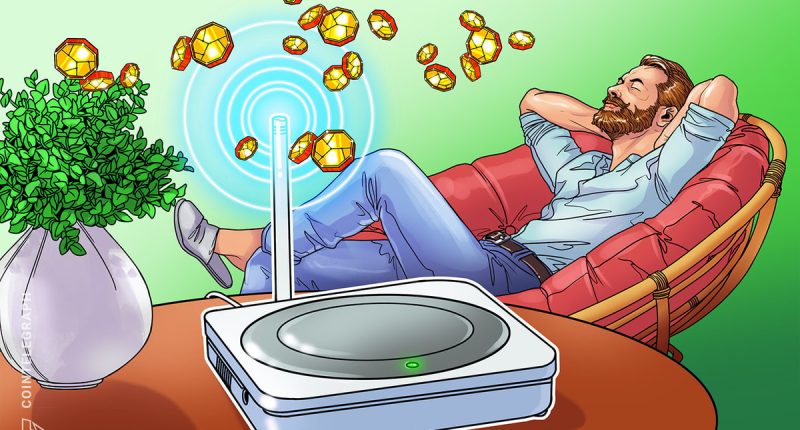Mining helps verify the legitimacy of transactions conducted via a blockchain network, such as the Bitcoin blockchain. Miners can start mining cryptocurrencies using hardware like a central processing unit (CPU) or application-specific integrated circuits (ASICs). Alternatively, they can use smartphones powered by Android and iOS systems to mine the cryptocurrencies of their choice.
While technically possible, mining cryptocurrencies on smartphones is generally impractical and inefficient. So, how about an innovative approach to mining and network infrastructure via a decentralized wireless network? Strange as it may sound, miners can mine cryptocurrencies without relying on expensive infrastructure. Helium Network has made it possible by allowing nodes to act as hotspot devices.
This article will discuss the Helium ecosystem, Helium mining, the HNT hotspot miner and how a Helium miner works.
What is the Helium network?
Helium is a dispersed network of hotspots that offers LoRaWAN-capable Internet of Things (IoT) devices, a long-range wireless service publicly accessible by global citizens. LoRaWAN stands for Long Range Wide Area Network, and IoT devices may communicate with one another via LoRa thanks to the open LoRaWAN protocol. IoT devices are smart “gadgets” that connect to a network and exchange data, offering a more comprehensive range of connectivity than WiFi.
Helium blockchain was developed exclusively to encourage the development of real, decentralized wireless networks. Helium uses HNT (Helium) tokens as its primary cryptocurrency. However, the project migrated to the Solana blockchain in April 2023.
This move made HNT natively compatible with projects — i.e., interoperability — within the Solana ecosystem while jacking up the utility of MOBILE and IOT tokens (other Helium tokens). MOBILE tokens aim to make creating and operating decentralized wireless networks seamless, with a particular emphasis on 5G and cellular services. By providing incentives for establishing and maintaining mobile data transmission infrastructure, MOBILE tokens allow for a decentralized method of cellular access.
The purpose of IOT tokens is to facilitate the IoT component of the Helium network. They ensure robust and extensive coverage for low-power Internet of Things devices by encouraging and facilitating the operation of LoRaWAN hotspots and related services. The IOT tokens greatly enhance the network’s utility and reach for IoT applications.
Furthermore, Solana’s architecture makes faster transaction speeds and more efficiency possible, incorporating innovations like proof-of-history (PoH). This is advantageous for the real-time needs of IoT devices and networks.
Hotspots and network participation
With Helium, anyone can own and manage a wireless IoT network using a unique, portable radio router known as a hotspot. Hotspots are wireless plug-and-play devices that offer superior connectivity to WiFi.
Hotspots are used by miners to build “The People’s Network,” a long-range wireless network that provides coverage for IoT devices with meager power requirements in exchange for HNT, the Helium blockchain’s native cryptocurrency. The Helium community has permitted third-party manufacturers to sell a range of Helium hotspots.
Proof-of-coverage (PoC) mechanism
Proof-of-coverage (PoC), a novel work algorithm, is used by the Helium blockchain to confirm that hotspots accurately describe their location and the wireless network coverage they are generating from it. Radio waves are used during the mining process, and hotspots are rewarded for acting as witnesses for peers’ performance, completing PoC challenges and sharing device data. The most valuable tool for viewing data linked to PoC is the Helium Network Explorer.
When the Helium network debuted in 2019, it employed a PoC system based on a sophisticated model comprising Challenger, Beaconer, Witness, Validator and Rewarder roles. This model aimed to accurately validate the geographical locations of hotspots and the corresponding wireless coverage they provided. As the network expanded rapidly and diversified, the complexity and sophistication of attempts to exploit the system increased, necessitating adaptations to maintain integrity and effectiveness.
As a result, Helium Improvement Proposal 70 introduced an oracle-based PoC system to streamline the process. In this system, hotspots are responsible for their own beacon transmissions, and a decentralized group of oracles validates PoC events. This reduces the network’s overhead and improves scalability and efficiency.
Advantages of the Helium Network
Pros of the Helium Network over a standard internet service provider include a high level of security, complete encryption and affordable universal internet access. Moreover, Helium’s decentralized architecture leverages the shared infrastructure of hotspots run by businesses and consumers to offer more affordable connection solutions, especially for IoT devices. This may make accessing the internet more accessible for those in rural or underserved areas.
Additionally, users do not need to bear charges that a cellular provider might impose, such as coverage fees or the cost of extra hardware like a SIM card. That said, users only pay for the data they used to connect their devices — i.e., pay-per-use — using the Helium Console to begin using the Helium Network.
Helium supports cutting-edge technologies like LoRaWAN for low-power devices, making it an ideal platform for many IoT applications, from smart agriculture to urban planning. Also, Helium empowers its users to be a part of the network’s expansion, offering incentives for hotspot hosts in the form of HNT rewards. This community-driven approach fosters a collaborative ecosystem.
What is a Helium miner?
Utilizing specialized hardware known as hotspots, Helium miners offer the Helium network wireless network coverage. By acquiring or constructing a WHIP-compliant hotspot and staking a token deposit corresponding to the density of other miners operating in their area, users become miners on the Helium network. WHIP stands for Wireless Hardware Interface Protocol.
In addition to the blockchain protocol, the Helium Wireless protocol called WHIP, a network of independent providers rather than a single coordinator, offers a bi-directional data transfer method between wireless devices and the internet.
The responsibility of validating hotspots to ensure that device data reaches its intended destination and that miners receive compensation for their services lies with internet applications known as routers — aka Helium Network servers. These routers purchase encrypted device data from miners, ensuring the integrity and accuracy of data transmission within the network.
In the Helium network, hotspots are of three types, as explained below:
- Full hotspots: These hotspots maintain a full copy of the HNT blockchain and receive rewards for all participation activities, including proof-of-coverage and data transfer.
- Light hotspots: With the help of the Light Hotspot software, these hotspots use validators to participate as full hotspots without incurring the additional costs of keeping a local copy of the blockchain. In addition, they are rewarded for proof-of-coverage and data transfer activities.
- Data-only hotspots: These hotspots provide data transfer capabilities for the network without participating in PoC challenges. As a result, they are rewarded for data transfer activities only.

How does Helium mining work?
Radiowave technology is utilized to carry out Helium mining instead of CPUs or ASICs. In addition, blockchain technology is used to create a wireless network that is more reliable than the network provided by established traditional wireless service providers. However, it is important to note that reliability can be subjective and context-dependent, varying based on network density, hotspot distribution and other factors.
Helium hotspots or miners provide long-range wireless coverage using special devices called LoRaWAN transmitters. So, how can one earn Helium tokens in return? By mining and expanding The People’s Network’s coverage with suitable hotspots, miners gain HNT. The reward amount is correlated with the data a miner will transfer — i.e., more money when miners transfer more device data. Other factors influencing HNT rewards include the number of devices served and the miner’s participation in PoC challenges.
In addition, the network automatically and randomly assigns proof-of-coverage tests to verify the location of hotspots (witnesses). Hotspots get directives or “challenges” from validators to communicate payloads to any nearby hotspots for observation and verification to participate in PoC. These difficulties are also referred to as “beacons.” However, as they can only mine HNT for data transfers and cannot have their beacons confirmed, HNT hotspot miners without neighbors get paid less.
Moreover, each compatible device needs data credits (DCs) to send data to the internet. DCs are created by burning HNT to achieve a burn and mint equilibrium (BME), which ensures a balance between the creation of new HNT through mining and the removal of HNT from circulation through the burning process. The BME model uses tokens as a proprietary form of payment, but customers who wish to use a service do not directly pay a counterparty. Instead, they burn tokens.
How to set up a Helium miner?
As mentioned in the above sections, a hotspot miner, antenna (and its location), cables, smartphone and router are the prerequisites to set up a Helium miner. But how does one find the best Helium miner? The position of antennas and one’s geographical location play a key role in finding a suitable Helium miner. The below steps provide an understanding of how one can set up a Helium miner:
Step 1: Download and set up a Helium app
The first step involves downloading the Helium app (available for Android and iOS) and setting up an account. After this, a Helium wallet will be generated that users can utilize to store their information.
The application will generate a 12-word seed phrase to back up the Helium wallet. The app will also prompt the user to create a six-digit PIN that must be entered each time when logging in as an additional security measure.
Step 2: Add a Helium miner
The next step is to find out the plus (+) symbol to add a Helium miner, for example, the RAK Hotspot Miner, to the app. The chosen miner needs to be plugged in to operate, and a tiny red light will confirm that it is working. Then, a button on the back of the device needs to be pressed for Bluetooth pairing. Alternatively, WiFi can be configured by choosing from the available network settings in the Helium app.

It should be noted that it is essential to choose a Helium miner that is reliable and approved by the Helium community. Potential buyers should look for hotspots that are compatible with their region’s frequency and have a good track record of performance and support.
Step 3: Select the hotspot, verify its location, and set up the antenna
Now, the list will include the chosen Hotspot Miner. To proceed, the user selects “Hotspot.” A prompt to add a hotspot will then appear. The user adds the hotspot, verifies the hotspot’s location, and configures the antenna.

The first assertion is free (paid by manufacturers), and users are responsible for paying the transaction fee (in HNT) for further assertions. If the user still needs to get ready to set a location, they can press “Skip.” If you are good to go, select “Continue.” The added Hotspot can be viewed and managed under the Hotspots tab of the mobile app.
After the hotspot is added and its location is asserted, it will begin to participate in the network activities, including PoC challenges and data transfer, earning HNT based on its performance.
How to optimize your Helium miner setup
The goal of optimizing a Helium miner setup is to maximize the radio frequency signal reach of the hotspot. Orienting the antenna to its highest point — ideally outside or close to a window — will help it stay clear of obstacles and improve its line of sight to neighboring hotspots.
The power and coverage of the signal can be greatly increased by using a high-gain antenna compatible with the frequency band used in the area. For the antenna to be protected from static damage and lightning strikes, it must be properly grounded.
Furthermore, updating the firmware of the hotspot to the most recent version ensures the best performance and security. In addition, it is crucial to consider the density of hotspots in the area; too close may result in signal overlap, while too far may make it impossible to take part in PoC challenges. Effective management of these factors can substantially boost the effectiveness and earnings of a Helium miner setup.
The future of the Helium network
The future of the Helium network looks promising, with its migration to Solana offering users enhanced support through both hardware and software wallets and integration with a wide array of Solana ecosystem applications. Despite the migration, HNT, MOBILE and IOT tokens retain their significance within the Helium ecosystem, unaffected by Solana’s native SOL (SOL) token.
The introduction of 5G and the transition to Solana as the primary blockchain layer have not altered the dynamics between MOBILE and HNT tokens. 5G hotspot owners will continue earning MOBILE tokens, while HNT holders can still stake their tokens.
The Helium network’s IoT and 5G segments are poised for growth, benefiting from the increased reliability and scalability offered by the new architecture. Innovations like the Solana Mobile Stack and Saga Phone are set to enrich the mobile experience within the ecosystem, further expanding Helium’s capabilities and reach.
Also Read More: World News | Entertainment News | Celebrity News








